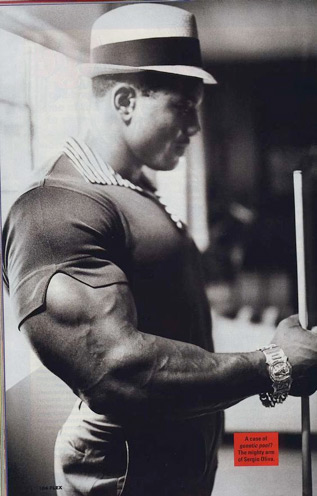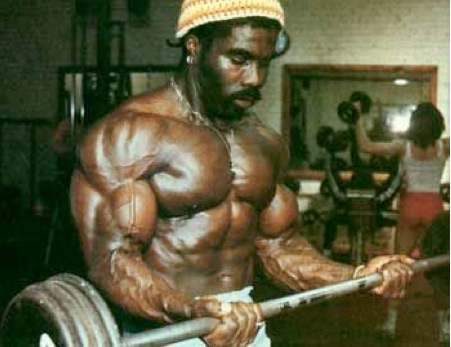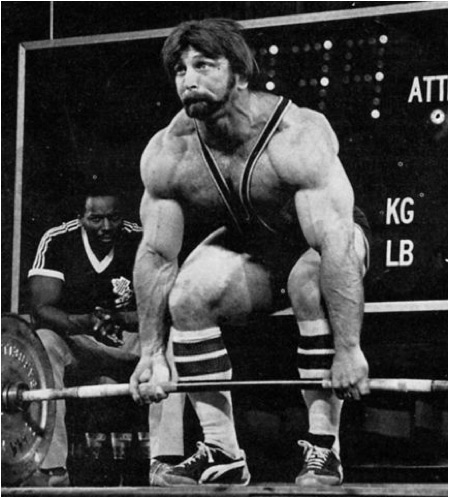
Training Volume versus Intensity
Workout by workout comparisons
Featured Weightlifting Equipment: dumbbell, bench press, barbell, weight belt, knee wraps
In the Bizzaro world of progressive resistance training two disparate paths can successfully transform the physique and elevate performance. Both approaches have a proven track record of tangible results; both schools have persuasive advocates and dramatically transformed devotees. You can, alternatively...
- flog the muscle to death: subscribe to a high volume/moderate intensity approach
- shoot the muscle thru the heart: subscribe to a high intensity/low volume approach
Choice #1 was bought to high art by the classic bodybuilders of the 1970s. These men were fulltime professional bodybuilders living the beach lifestyle. Weight training was their job and they put in a lot of hours. Choice #2 is a quote Dorian Yates made when asked about his training approach, "Rather than waste all that time flogging a muscle to death with endless resistance training, why not shoot it through the heart? Once dead, there is no need to keep pumping bullets into the body." This is a brilliant analogy and a nice summation of his stance in the intensity versus volume debate.
You cannot deny the fabulous physiques of the old timers, please don't tell me volume training doesn't work because Arnold, Sergio, Franco, Robbie, Zane, et al were functional and athletic. They built sensational physiques before drug Armageddon ate pro bodybuilding alive. Back then there were drugs, but the drugs were not the determinate factor. Drugs made everyone 10% better, but everyone used the same ‘gear' in the same amounts (laughably small by modern standards) so results were evenly distributed.
The strategy these hall-of-fame bodybuilders used was uniform: subject oneself to an ungodly amount of weight training, i.e. volume - set after endless set, six days a week, often training twice a day. As reported in this column previously, Arnold, at his awesome mid-70s peak was performing no less than 700 sets per week. That's no typo bucko. And all of the greats used this approach. Check out Robbie Robinson's three times a week arm (bicep/tricep) routine...
Tuesdays, Thursdays, Saturdays
| Biceps | ||
| Barbell cheat curls | 8 sets | 6-8 reps |
| Seated dumbbell incline curls | 6 sets | 8 reps |
| Concentration curls | 6 sets | 10 reps |
| Close grip barbell curls | 6 sets | 12 reps |
| Triceps | ||
| Single-arm triceps extension | 8 sets | 10 reps |
| Narrow-grip bench press | 6 sets | 8 reps |
| Triceps pushdowns | 6 sets | 8-10 reps |
| Dips | 6 sets | 10-12 reps |
52 sets per session; 156 sets of arms every week
Robbie would super-set, alternate bicep and tricep exercises; cheat curls alternated with single arm tri extensions, then incline dumbbell curls alternated with narrow-grip bench press and so on, this way he could do twice the work in half the time.

The Black Prince at work: proof positive volume works
In the same workout Robbie trained arms, he also trained shoulders, calves and abs (82 sets.) Later that same day, in the afternoon, he returned to the gym to perform 54 sets of super-setted calves and abs. This twice a day routine was repeated three times a week. On three different days a week Robbie trained chest and back in the morning (64 sets) and came back at night to blast thighs, calves and abs (79 sets.) Add it all up and it came to a staggering 825 sets per week. Don't tell me it doesn't work - but please God - can't there be an effective alternative?
Volume bodybuilding seems akin to volunteering to work as a Siberian coal miner for free or perhaps asking to become a prison camp laborer. Yet all the West Coast greats of that era trained using this same approach. Jeff Everson once saw Sergio super-set 15 sets of chins with 15 sets of bench presses (using 255) all sets done for 15 reps and all were done in less than 30 minutes.
Flogging muscles to death: volume becomes the thesis
There is an irrefutable inverse ratio between volume and intensity. If you set out to perform 52 sets for your arms (no matter who you are) in order to make it across the finish line you have to pace yourself. You cannot give 100% for 52 straight sets. The best you can aspire to is one, or perhaps two, all-out sets per exercise.
Thesis, antithesis, synthesis: the Hegelian dialectic holds that if volume is the orthodox thesis, as it was in the Arnold era, eventually the antithesis will arise. Ultimately, after the antithesis has taken over, an eventual blending occurs, a synthesis. Over time the synthesis morphs into the new thesis and we begin anew. The volume thesis was supplanted by intensity and the synthesis has been occurring since Jay Cutler captured his first Olympia.
Shooting the muscle through the heart: the Mac Daddy of intensity
Power training mixes extreme minimalism with extreme intensity. This school of strength has archetypical techniques, a purposefully limited training menu and a highly specific series of interrelated protocols and procedures. The main identifying characteristics of hardcore intensity training are (1.) an ongoing quest for technical improvement as a way to improve lift performance and (2.) adherence to a periodized game plan.
Techniques are honed on the key lifts over time and with practice. The training template has a simple goal: improve poundage handling ability in four key exercises. The goal is to build a bigger squat, bench, deadlift and overhead press. Any muscle mass built along the way is strictly a spin-off side benefit. As it turns out, the optimal way in which to build maximum muscle size is to follow the power training strategy.
What bodybuilders discovered is that the surefire way to grow significantly bigger was to grow significantly stronger - and not as in tricep kickbacks or leg extensions - want bigger legs? Get a bigger barbell squat. Want a better back? Get a bigger deadlift. Want massive pecs and tris? Get a massive bench press. Better shoulders? Bigger overhead press. Simple Simon stuff actually.
Power trainers concentrate on four compound multi-joint barbell and dumbbell exercises that require groups of muscles to work together in sequential synchronization to compete the muscular task. The squat, bench press, deadlift and overhead press are performed one time each week - not three times a week. Champion powerlifters, men setting world records and winning world titles, were performing 70 to 80 sets per week (sometimes less,) one-tenth the volume used by Arnold and Robbie. The elite powerlifters built massive amounts of muscle, muscle size that exceeded that built by volume bodybuilders, and they did it in a fraction of the time.
One look at the physiques and feats of intensity-biased bodybuilders or Old School champion powerlifters puts to rest any questions about the effectiveness of this approach. This minimalistic strength system was used by world champion athletes to set world records that stand to this day, two and three decades later. The force multiplier for getting away with minimum training volume is exerting maximum training intensity.
So how did the monstrous powerlifting champions of the 70s, 80s and 90s create optimal strength training intensity? Each week for twelve successive weeks, payloads were systematically increased. Each week the power trainer demanded more of themselves; each successive week they forcibly morphed the body, becoming slightly bigger (literally,) slightly stronger and slightly more aggressive, centered, focused and motivated. Midway thru a successful 12 week cycle and momentum would take root. By "cycles" end, both physique and performance were catapulted to the next level.

Man amongst men: irrefutable evidence minimalistic intensity training works Roger Estep pulls 766 in the 198 pound class in 1979. Old school lifters built incredible muscle.
Old School Power Training Template
| Monday | squat |
| Tuesday | off |
| Wednesday | bench press, inclines, triceps, biceps |
| Thursday | off |
| Friday | deadlifts, grip shrugs, press-behind-neck |
| Saturday | off |
| Sunday | off |
Each week the poundage is increased in the squat, bench press, deadlift and press-behind-the-neck. Predetermined poundage and reps are used to coax progress incrementally.
High-intensity periodization is successful when the athlete is coldly realistic in their initial self-assessments and realistic in their goal setting. Initially, in the beginning phases of a high-intensity power cycle, the weightlifter might start off as much as 30% below capacity, this on an across the board basis. The goal would be to end the cycle 5 to 15% above current capacities.
During the light initial stage, the lifter would use "intensity enhancing" techniques to "make light weights heavy." Intensity enhancers might include, no supportive gear, not even a weight belt or knee wraps, using extreme range of motion, adding in pauses, standing on blocks when deadlifting, slowing down the negatives, using drop sets for arms, etc.
The successful cycle is self-justifying: hit each weekly goal and the overarching goal takes care of itself. This elemental strategy has been used to set records that might never be broken. Will any 219 pound human ever deadlift 900 after squatting 960 like King Coan? Will any other 265 pound lifter ever exceed 800 x 5 reps in the barbell squat, every rep below parallel, wearing only a weightlifting belt like Karwoski? Will another 130-pound human ever deadlift 687 pounds, like Lamar Gant in 1980? I seriously doubt it. These records have stood for decades with no serious challenges and no one even remotely approaching these marks.
Ancient power immortals were straight-line periodization devotees. All the strength greats of the 70s, 80s and 90s trained fundamentally the same: high intensity, relatively low volume and an unrelentingly dedication to ratcheting up the poundage each successive week, come hell or high water. The bottom line is you can get by with less (volume) if less is more intense. Are you flogging your muscles? Perhaps you should consider shooting them.
About the Author
As an athlete Marty Gallagher is a national and world champion in Olympic lifting and powerlifting. He was a world champion team coach in 1991 and coached Black's Gym to five national team titles. He's also coached some of the strongest men on the planet including Kirk Karwoski when he completed his world record 1,003 lb. squat. Today he teaches the US Secret Service and Tier 1 Spec Ops on how to maximize their strength in minimal time. As a writer since 1978 he’s written for Powerlifting USA, Milo, Flex Magazine, Muscle & Fitness, Prime Fitness, Washington Post, Dragon Door and now IRON COMPANY. He’s also the author of numerous books including Purposeful Primitive, Strong Medicine, Ed Coan’s book “Coan, The Man, the Myth, the Method" and numerous others. Read the Marty Gallagher biography here.

